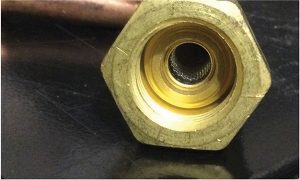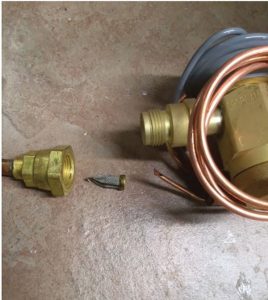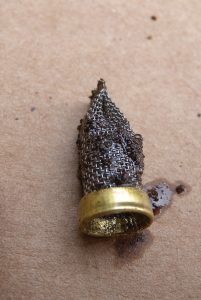
The Troubles I Have Seen
January 13, 2021 | By Ian McTeer
Sharp eyesight, an inquisitive mind and deductive reasoning are all required when solving HVAC problems.

We all make mistakes, nobody’s perfect!
Such a common refrain seemingly illustrates a universal human truth. Mistakes however often lead to consequences: in fact this morning I mistyped my computer PIN code twice (caps were on) and got locked-out for half an hour. Minor mistake, minor consequence.
An industry of psychologists, also known as “life coaches,” help us to deal with missteps, mess-ups, and misunderstandings under the banner of learning from one’s mistakes. On the other hand, Einstein said that a person who never made a mistake never tried anything new.
Mistakes inevitably lead to some sort of trouble, maybe just a minor consequence like my typing error, but trouble tends to exhibit itself on a sliding scale with not much more than a little ouch at one end escalating to property damage, injury or death at the other.
Thus, avoiding trouble in the HVAC world means mistakes must be minimized by utilizing an on-going commitment to quality control. Taking the time to specify equipment appropriately, installing and commissioning it correctly and to maintain a service routine is the best way, in my mind, to avoid trouble.
It is true that some contractors have little regard for quality work, but it’s also very true that equipment owner’s too often have an unrealistic expectation of the product (perhaps related to a miscommunication mistake) or otherwise abuse HVAC systems through lack of maintenance. I long ago learned to never side with either the contractor or the equipment user; my job is to understand why the equipment is causing so much trouble. (Insider secret: sometimes it IS the equipment!)
I want to describe two situations in which furious end-users combined with frustrated contractors all at war over what appeared to be faulty equipment led to troubles galore.
The Reluctant TXV
Our government decided back in 2006 that residential split system air conditioners should operate at a minimum efficiency of 13 SEER going into the future. I’m all for efficiency, however, this particular requirement had an unusual consequence in that many outdoor unit and indoor coil combinations now required a thermostatic expansion valve (TXV) metering device in order to meet the updated requirement.
I have been a TXV champion ever since I learned how they worked, yet industry members thought capillary tubes and metering pistons did an acceptable job at a much lower price, therefore, TXV’s were rarely used in residential application up until 2006.
Far too many contractors and technicians had either forgotten or were unaware of the subtle differences in charging requirements and troubleshooting techniques between the different devices.
Add to that, some TXV’s started coming onto the market with manufacturing defects at the very same time. Some TXV’s had diaphragm failures, others had leaking sensor bulbs, some even had contaminated desiccant inside the sensor bulb.
All these defects caused the valve to fail closed or partially closed leading to a diagnosis of unacceptably high superheat. Service bulletins were issued describing the problem, specifying model numbers, date codes and troubleshooting guides. But, once the bad news started winding its way through the HVAC community, too often valves, even entire evaporator coils, were coming back for warranty exchanges all indicted with the high superheat menace.
I received a call from our parts department one day. A technician was at the counter looking for his fourth replacement TXV on the same unit.
The counter person told me the third valve’s date code was outside of the range specified in the service bulletin, so I suggested they give him another one and that I’d meet the technician on the job.
Upon arrival at the job site, there was no technician just a furious homeowner who told me the installing contractor was no longer welcome. A blistering hot day, to be sure, and the old system recently dispatched to the recycler had at least been working.

Figure 1.
Going into his second week without cooling, and no solution in sight now that he had fired the contractor, the frustrated customer allowed me to inspect the job. The system charge had been removed so the tech could unbolt the third replacement TXV from the evaporator coil. I noticed the brass female connector standing open in the evaporator coil case had a small amount of compressor oil inside the fitting with a brownish tint and gritty feel: not good! (see Figure 1)

Figure 2.
I extricated the filter strainer from inside the open fitting using a small screwdriver (not recommended, use a pick tool). Yes, there’s a removable strainer in there! (see Figure 2)
The strainer contained enough dirt and debris to create a substantial blockage, no wonder high superheat appeared to be the trouble (see Figure 3). Because the tech was aware of the service bulletin implicating some TXV’s as problematic, in his mind, all TXV’s were suspect.

Figure 3.
It turns out the homeowner asked the installer to place the unit in a different location from the original unit. The interconnecting line set had to be run underneath a closed-in deck.
The installation crew made no attempt to seal the tubing as it passed through the dirt under the deck – both the liquid and suction tubing contained debris. In the end, we had another contractor replace the entire system at no charge to the homeowner. Problem solved.
The Case of the Wrong Furnace
Fortunately, it was not every day that furious homeowners contacted me threatening legal action, but one time was too many in my mind. However, taking the heat is what I was getting paid for.
In most HVAC disputes there are three parties: the contractor, the end user, and a silent party—the equipment.
Initially, my main concern caused me to take the side of the installed products. This situation had all the hallmarks of serious trouble related to miscommunication on all sides: installation errors, lack of commissioning and even the municipality failed to pick-up on the real issue at the time of occupancy.
Another blistering hot summer’s day pushed the homeowner, a retired accountant, to dig deep into the HVAC industry’s team roster eventually finding my contact information. Once on the line with me, the homeowner informed me that a lawyer’s letter would be on its way shortly demanding satisfaction for extremely poor heating and cooling performance from his essentially brand-new comfort system.
The well-off senior lived in a newly-established gated community, his roomy townhouse featured a loft with windows facing west and a partially finished basement.
“I’ll arrange a meeting with you and the contractor,” I told him.
“Not a chance, the site contractor is not welcome—his tech has been here many times and the problems have not been corrected, that’s why I’m calling you,” he replied.
I managed to get a well-qualified technician from another company to meet me at the job site. The homeowner allowed us to inspect the system. Considering the size of the house, optional loft included, and its large windows, I thought the two-ton air conditioner might have been undersized for the application.
It was operational, but the room temperature and humidity level hadn’t been mitigated to an acceptable level of comfort. We found that the cooling system employed a non-AHRI matched evaporator coil, that, technically speaking, wouldn’t have been a major problem.
We did find the furnace blower wheel and secondary heat exchanger covered in drywall dust. During a second visit, we replaced the evaporator coil with a matched component, cleaned the furnace, set the system charge correctly, and determined (without documentation) that airflow to the loft should be adequate as he told us there was practically no air to the loft previously. Problem solved, I thought!
During one of the many visits by the installing contractor’s service technician, the homeowner learned from the tech, and rightfully so, that cooling systems work best when window curtains are kept closed during the day.
Not wanting to spoil his view, the homeowner spent thousands of dollars having heat mirror window decals installed, although I’d argue the effect proved to be marginal at best. All our efforts made only minor comfort improvements, he had even covered the south and west facing windows with blankets to further reduce passive heating.
Back to the drawing board. I had noticed something about the ductwork on my first visit. It seemed to be much larger than required for a 60K Btu/h furnace and 2.0-ton cooling unit.
There is no good reason to oversize the duct system, no contractor would spend extra dollars on unnecessary sheet metal.
“Let’s talk to the building inspector,” I suggested.
I wanted to see the approved HVAC plan for his house. The municipality reluctantly agreed to send an inspector with the plans, whereupon we discovered the furnace should have been 80K Btu/h and the cooling unit should have been 2.5 tons. How could that have happened?
I know the contractor did not intend to install undersized equipment. My theory worked this way: the building site featured similarly-sized linked semi-detached bungalows. Some models had the loft option thus requiring a beefier HVAC system.
Having started-off in HVAC by delivering furnaces and duct jobs to new construction sites myself, I can attest to the fact that sometimes the housing units under construction are poorly marked or the delivery information is sketchy; whatever, I suspect the delivery crew got the ductwork right but the equipment wrong.
Somewhere on that site, to this day, exists a non-loft unit with an oversized furnace and air conditioner no one has ever complained about. And because the 60K model furnace and the 80K model are in the exact same sized cabinet, the sheet metal installers simply plugged the 60K unit sitting there waiting for them into the duct job they found in the basement. The installers nor the technician who came along later had any idea the equipment was incorrect.
The inexperienced technician tried and tried to make a silk purse out of a sow’s ear, and even though he made an effort, however misguided, the initial mistakes meant he could never satisfy the homeowner.
I have long thought a laminated copy of the approved heating plan, including the worksheet load calculation containing room by room air flow values, should become part of every residential installation. Such information is an invaluable guide for proper commissioning, future equipment troubleshooting, potential renovations or future additions to the house.
Had such data been left behind in my circumstance, perhaps the error would have been corrected sooner saving the homeowner countless hours of frustration and expense.
Yes, the equipment was replaced at no cost to the homeowner two years after the fact.
Some mistakes are truly doozies: a tiny grinding error in the primary mirror of the Hubble Space Telescope amounting to 1/50th the thickness of a human hair cost nearly $1 billion to repair. And in the HVAC world, a study authored by Sarah Lynn Garrett of Kansas State University described how an oversized cooling system combined with a plethora of errors during the construction of the Polk County courthouse in Bartow, Florida cost $35 million to repair, millions more than the original cost of the entire 10-storey building!
Philosophers call it schadenfreude: those who experience pleasure, even joy, in hearing about the troubles, humiliation or failures of others. Such an attitude was not top of mind as I thought about how I could describe several very problematic situations I’ve experienced.
Trouble often results from more than just one error; yes, some are carelessly caused, even reckless, yet we are all capable of misadventures; unfortunately, sometimes those that end very badly.
Thus, learning from mistakes is one thing, but what one does or doesn’t do about them makes all the difference. <>

 Ian McTeer is an HVAC consultant with 35 years of experience in the industry. He was most recently a field rep for Trane Canada DSO. McTeer is a refrigeration mechanic and Class 1 Gas technician.
Ian McTeer is an HVAC consultant with 35 years of experience in the industry. He was most recently a field rep for Trane Canada DSO. McTeer is a refrigeration mechanic and Class 1 Gas technician.


